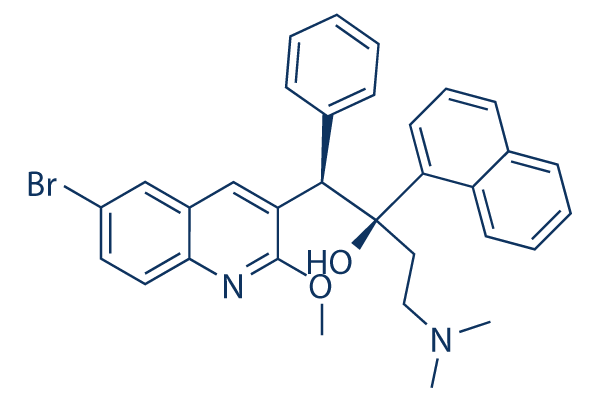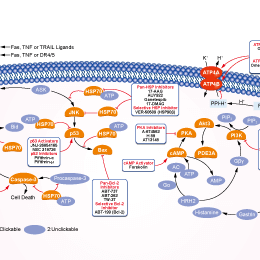
- Bioactive Compounds
- By Signaling Pathways
- PI3K/Akt/mTOR
- Epigenetics
- Methylation
- Immunology & Inflammation
- Protein Tyrosine Kinase
- Angiogenesis
- Apoptosis
- Autophagy
- ER stress & UPR
- JAK/STAT
- MAPK
- Cytoskeletal Signaling
- Cell Cycle
- TGF-beta/Smad
- DNA Damage/DNA Repair
- Compound Libraries
- Popular Compound Libraries
- Customize Library
- Clinical and FDA-approved Related
- Bioactive Compound Libraries
- Inhibitor Related
- Natural Product Related
- Metabolism Related
- Cell Death Related
- By Signaling Pathway
- By Disease
- Anti-infection and Antiviral Related
- Neuronal and Immunology Related
- Fragment and Covalent Related
- FDA-approved Drug Library
- FDA-approved & Passed Phase I Drug Library
- Preclinical/Clinical Compound Library
- Bioactive Compound Library-I
- Bioactive Compound Library-Ⅱ
- Kinase Inhibitor Library
- Express-Pick Library
- Natural Product Library
- Human Endogenous Metabolite Compound Library
- Alkaloid Compound LibraryNew
- Angiogenesis Related compound Library
- Anti-Aging Compound Library
- Anti-alzheimer Disease Compound Library
- Antibiotics compound Library
- Anti-cancer Compound Library
- Anti-cancer Compound Library-Ⅱ
- Anti-cancer Metabolism Compound Library
- Anti-Cardiovascular Disease Compound Library
- Anti-diabetic Compound Library
- Anti-infection Compound Library
- Antioxidant Compound Library
- Anti-parasitic Compound Library
- Antiviral Compound Library
- Apoptosis Compound Library
- Autophagy Compound Library
- Calcium Channel Blocker LibraryNew
- Cambridge Cancer Compound Library
- Carbohydrate Metabolism Compound LibraryNew
- Cell Cycle compound library
- CNS-Penetrant Compound Library
- Covalent Inhibitor Library
- Cytokine Inhibitor LibraryNew
- Cytoskeletal Signaling Pathway Compound Library
- DNA Damage/DNA Repair compound Library
- Drug-like Compound Library
- Endoplasmic Reticulum Stress Compound Library
- Epigenetics Compound Library
- Exosome Secretion Related Compound LibraryNew
- FDA-approved Anticancer Drug LibraryNew
- Ferroptosis Compound Library
- Flavonoid Compound Library
- Fragment Library
- Glutamine Metabolism Compound Library
- Glycolysis Compound Library
- GPCR Compound Library
- Gut Microbial Metabolite Library
- HIF-1 Signaling Pathway Compound Library
- Highly Selective Inhibitor Library
- Histone modification compound library
- HTS Library for Drug Discovery
- Human Hormone Related Compound LibraryNew
- Human Transcription Factor Compound LibraryNew
- Immunology/Inflammation Compound Library
- Inhibitor Library
- Ion Channel Ligand Library
- JAK/STAT compound library
- Lipid Metabolism Compound LibraryNew
- Macrocyclic Compound Library
- MAPK Inhibitor Library
- Medicine Food Homology Compound Library
- Metabolism Compound Library
- Methylation Compound Library
- Mouse Metabolite Compound LibraryNew
- Natural Organic Compound Library
- Neuronal Signaling Compound Library
- NF-κB Signaling Compound Library
- Nucleoside Analogue Library
- Obesity Compound Library
- Oxidative Stress Compound LibraryNew
- Plant Extract Library
- Phenotypic Screening Library
- PI3K/Akt Inhibitor Library
- Protease Inhibitor Library
- Protein-protein Interaction Inhibitor Library
- Pyroptosis Compound Library
- Small Molecule Immuno-Oncology Compound Library
- Mitochondria-Targeted Compound LibraryNew
- Stem Cell Differentiation Compound LibraryNew
- Stem Cell Signaling Compound Library
- Natural Phenol Compound LibraryNew
- Natural Terpenoid Compound LibraryNew
- TGF-beta/Smad compound library
- Traditional Chinese Medicine Library
- Tyrosine Kinase Inhibitor Library
- Ubiquitination Compound Library
-
Cherry Picking
You can personalize your library with chemicals from within Selleck's inventory. Build the right library for your research endeavors by choosing from compounds in all of our available libraries.
Please contact us at [email protected] to customize your library.
You could select:
- Antibodies
- Bioreagents
- qPCR
- 2x SYBR Green qPCR Master Mix
- 2x SYBR Green qPCR Master Mix(Low ROX)
- 2x SYBR Green qPCR Master Mix(High ROX)
- Protein Assay
- Protein A/G Magnetic Beads for IP
- Anti-Flag magnetic beads
- Anti-Flag Affinity Gel
- Anti-Myc magnetic beads
- Anti-HA magnetic beads
- Magnetic Separator
- Poly DYKDDDDK Tag Peptide lyophilized powder
- Protease Inhibitor Cocktail
- Protease Inhibitor Cocktail (EDTA-Free, 100X in DMSO)
- Phosphatase Inhibitor Cocktail (2 Tubes, 100X)
- Cell Biology
- Cell Counting Kit-8 (CCK-8)
- Animal Experiment
- Mouse Direct PCR Kit (For Genotyping)
- New Products
- Contact Us
Bedaquiline
Synonyms: TMC-207, R207910
Bedaquiline (TMC-207, R207910), a diarylquinoline, binds to subunit c of mycobacterial ATP synthase and inhibits its activity. It is highly selective for mycobacterial ATP synthase enzyme compared to homologous eukaryotic enzyme (Selectivity Index >20 000).

Bedaquiline Chemical Structure
CAS No. 843663-66-1
Purity & Quality Control
Batch:
Purity:
99.99%
99.99
Bedaquiline Related Products
| Related Targets | V-ATPase F-ATPase SERCA RecA AAA ATPase family | Click to Expand |
|---|---|---|
| Related Products | Brefeldin A (BFA) (-)-Blebbistatin CB-5083 Omecamtiv mecarbil (CK-1827452) Thapsigargin Sodium orthovanadate Golgicide A BTB06584 Ginsenoside Rb1 CDN1163 Periplocin Rhodamine 123 tetrathiomolybdate Saikosaponin D | Click to Expand |
| Related Compound Libraries | FDA-approved Drug Library Natural Product Library Ion Channel Ligand Library Exosome Secretion Related Compound Library Calcium Channel Blocker Library | Click to Expand |
Signaling Pathway
Biological Activity
| Description | Bedaquiline (TMC-207, R207910), a diarylquinoline, binds to subunit c of mycobacterial ATP synthase and inhibits its activity. It is highly selective for mycobacterial ATP synthase enzyme compared to homologous eukaryotic enzyme (Selectivity Index >20 000). | |
|---|---|---|
| Targets |
|
| In vitro | ||||
| In vitro | Bedaquiline targets against Mycobacterial ATP synthase complex[1]. Bedaquiline has anti-cancer activity, directed against Cancer Stem-like Cells (CSCs). Bedaquiline treatment of MCF7 breast cancer cells inhibits mitochondrial oxygen-consumption, as well as glycolysis, but induces oxidative stress. Bedaquiline reduces mitochondrial membrane potential, with a significant rise in ROS levels. It specifically inhibits mitochondrial respiration in cancer cells, while enhancing mitochondrial function in normal cells. Bedaquiline dramatically inhibits oxygen consumption and ATP production in the low micromolar range. In addition, bedaquiline treatment also reduced aerobic glycolysis[2]. | |||
|---|---|---|---|---|
| Cell Research | Cell lines | MCF-7 cells | ||
| Concentrations | 1μM and 10 μM | |||
| Incubation Time | 48 h | |||
| Method | MCF7 cells were treated with 10μM bedaquiline for 48 hours. Vehicle alone (DMSO) control cells were processed in parallel. After 48 hours, cells were washed with PBS, and incubated with CM-H2DCFDA (diluted in PBS/CM to a final concentration of 1 μM) for 20 minutes at 37°C. All subsequent steps were performed in the dark. Cells were rinsed, harvested, and re-suspended in PBS/CM. Cells were then analyzed by flow cytometry. |
|||
| In Vivo | ||
| In vivo | Bedaquiline follows triphasic elimination and characterized by an outstandingly long terminal half-life, around 173 h in humans[1]. | |
|---|---|---|
| NCT Number | Recruitment | Conditions | Sponsor/Collaborators | Start Date | Phases |
|---|---|---|---|---|---|
| NCT05175794 | Recruiting | Drug Resistant Tuberculosis|MDR-TB|XDR-TB|Tuberculosis |
Centre for the AIDS Programme of Research in South Africa|KNCV Tuberculosis Foundation|Amsterdam Institute for Global Health and Development|Ospedale San Raffaele|Foundation for Innovative New Diagnostics Switzerland|National Institute for Medical Research Tanzania|University of St Andrews|Global Alliance for TB Drug Development|Wits Health Consortium (Pty) Ltd|Institute of Human Virology Nigeria|Ethiopian Public Health Institute |
May 26 2022 | -- |
| NCT04239326 | Completed | Tuberculosis Multidrug-Resistant |
Foundation for Innovative New Diagnostics Switzerland |
April 16 2021 | -- |
Chemical Information & Solubility
| Molecular Weight | 555.50 | Formula | C32H31BrN2O2 |
| CAS No. | 843663-66-1 | SDF | -- |
| Smiles | CN(C)CCC(C1=CC=CC2=CC=CC=C21)(C(C3=CC=CC=C3)C4=C(N=C5C=CC(=CC5=C4)Br)OC)O | ||
| Storage (From the date of receipt) | 3 years -20°C powder | ||
|
In vitro |
DMSO : 33 mg/mL ( (59.4 mM) Moisture-absorbing DMSO reduces solubility. Please use fresh DMSO.) Water : Insoluble Ethanol : Insoluble |
Molecular Weight Calculator |
|
In vivo Add solvents to the product individually and in order. |
In vivo Formulation Calculator |
||||
Preparing Stock Solutions
Molarity Calculator
In vivo Formulation Calculator (Clear solution)
Step 1: Enter information below (Recommended: An additional animal making an allowance for loss during the experiment)
mg/kg
g
μL
Step 2: Enter the in vivo formulation (This is only the calculator, not formulation. Please contact us first if there is no in vivo formulation at the solubility Section.)
% DMSO
%
% Tween 80
% ddH2O
%DMSO
%
Calculation results:
Working concentration: mg/ml;
Method for preparing DMSO master liquid: mg drug pre-dissolved in μL DMSO ( Master liquid concentration mg/mL, Please contact us first if the concentration exceeds the DMSO solubility of the batch of drug. )
Method for preparing in vivo formulation: Take μL DMSO master liquid, next addμL PEG300, mix and clarify, next addμL Tween 80, mix and clarify, next add μL ddH2O, mix and clarify.
Method for preparing in vivo formulation: Take μL DMSO master liquid, next add μL Corn oil, mix and clarify.
Note: 1. Please make sure the liquid is clear before adding the next solvent.
2. Be sure to add the solvent(s) in order. You must ensure that the solution obtained, in the previous addition, is a clear solution before proceeding to add the next solvent. Physical methods such
as vortex, ultrasound or hot water bath can be used to aid dissolving.
Tech Support
Answers to questions you may have can be found in the inhibitor handling instructions. Topics include how to prepare stock solutions, how to store inhibitors, and issues that need special attention for cell-based assays and animal experiments.
Tel: +1-832-582-8158 Ext:3
If you have any other enquiries, please leave a message.
* Indicates a Required Field
Tags: buy Bedaquiline | Bedaquiline supplier | purchase Bedaquiline | Bedaquiline cost | Bedaquiline manufacturer | order Bedaquiline | Bedaquiline distributor







































